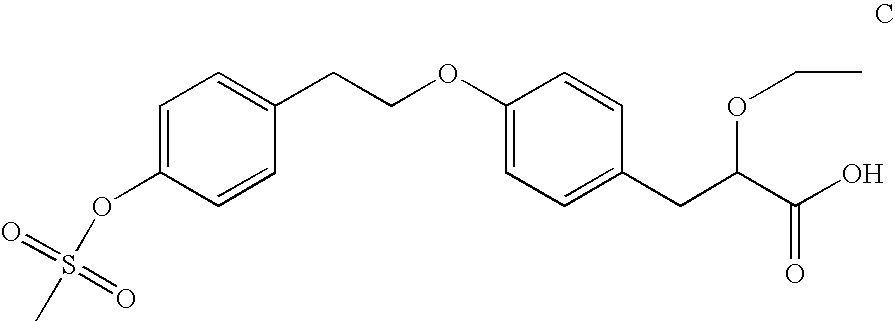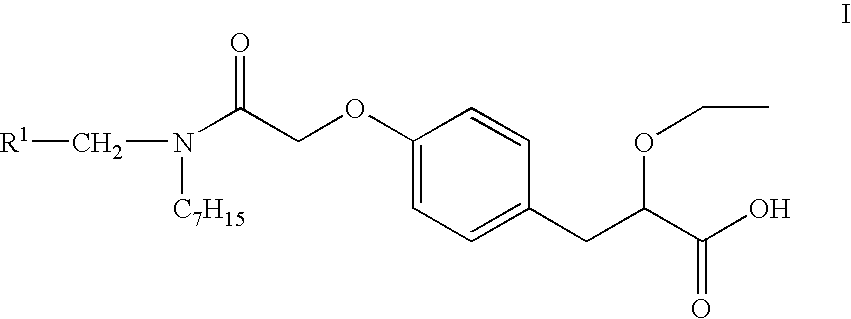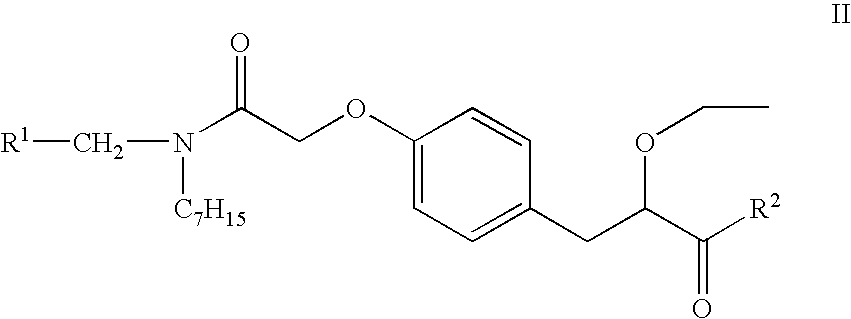Substituted phenypropionic acid derivatives as agonists to human peroxisome proliferator-activated receptor alpha (ppar)
a technology of human peroxisome proliferator and derivatives, which is applied in the direction of drug compositions, bulk chemical production, metabolic disorders, etc., can solve the problems of not being universally accepted as a diagnosis for individuals with insulin resistance and a greatly increased risk of cardiovascular morbidity and mortality
- Summary
- Abstract
- Description
- Claims
- Application Information
AI Technical Summary
Benefits of technology
Problems solved by technology
Method used
Image
Examples
example 1
(2S)-3-(4-{2-[(Cyclohexylmethyl)(heptyl)amino]-2-oxoethoxy}phenyl)-2-ethoxypropanoic Acid
(i) Ethyl(2S)-3-4-[2-(benzyloxy)-2-oxoethoxy]phenyl 1-2-ethoxypropanoate
[0134] To a solution of ethyl(2S)-2-ethoxy-3-(4-hydroxyphenyl)propanoate (23.8 g, 100 mmol, prepared as described in WO99 / 62872) in acetonitrile (200 mL) was added anhydrous potassium carbonate (31.9 g, 231 mmol) followed by benzyl bromoacetate (17.4 mL, 110 mmol) and the reaction mixture was refluxed overnight. The reaction mixture was allowed to cool to room temperature, insoluble salts were filtered off and the solution was concentrated in vacuo. The residue was taken up in ethyl acetate (300 mL), and the organic phase was washed with aqueous NaHCO3 (3×100 mL) and brine (100 mL), dried over anhydrous MgSO4, and concentrated in vacuo. Purification on silica gel with methylene chloride as the eluent and collection of pure fractions yielded 22.4 g (58%) of a yellow oil.
[0135]1H NMR (400 MHz, CDCl3): δ 1.16 (t, 3H), 1.22 (...
example 2
(2S)-3-(4-{2-[(2,4-Difluorobenzyl)(heptyl)amino]-2-oxoethoxy}phenyl)-2-ethoxypropanoic Acid
(i) N-(2,4-Difluorobenzyl)heptanamide
[0153] To a solution of 2,4-difluorbenzylamine (0.43 g, 3.0 mmol) in methylene chloride (30 mL) were added heptanoic acid (0.39 g, 3.0 mmol) and DMAP (0.37 g, 3.0 mmol) followed by 1-ethyl-3-(3-dimethylaminopropyl)carbodiimide hydrochloride (0.58 g, 3.0 mmol) and the reaction mixture was stirred at room temperature overnight. The mixture was diluted with methylene chloride (100 mL), and the organic phase was washed with 5% HCl (3×75 mL), aqueous NaHCO3 (75 mL) and brine (75 mL), and dried over Na2SO4. Concentration in vacuo afforded 0.63 g (82%) of a yellow oil.
[0154]1H NMR (400 MHz, CDCl3): δ 0.83-0.91 (m, 3H), 1.22-1.35 (m, 6H), 1.56-1.68 (m, 2H), 2.19 (t, 2H), 4.43 (d, 2H), 5.80 (bs, 1H), 6.75-6.88 (m, 2H), 7.33 (m, 1H).
[0155]13C NMR (100 MHz, CDCl3): δ 14.1, 22.6, 25.7, 29.0, 31.6, 36.8, 37.1, 104.0 (t), 111.5 (dd), 131.5 (dd), 173.2. (Non-protonate...
PUM
| Property | Measurement | Unit |
|---|---|---|
| temperature | aaaaa | aaaaa |
| temperature | aaaaa | aaaaa |
| 1H frequencies | aaaaa | aaaaa |
Abstract
Description
Claims
Application Information
 Login to View More
Login to View More - R&D
- Intellectual Property
- Life Sciences
- Materials
- Tech Scout
- Unparalleled Data Quality
- Higher Quality Content
- 60% Fewer Hallucinations
Browse by: Latest US Patents, China's latest patents, Technical Efficacy Thesaurus, Application Domain, Technology Topic, Popular Technical Reports.
© 2025 PatSnap. All rights reserved.Legal|Privacy policy|Modern Slavery Act Transparency Statement|Sitemap|About US| Contact US: help@patsnap.com



